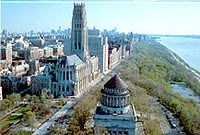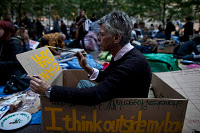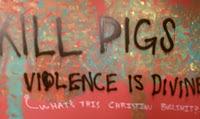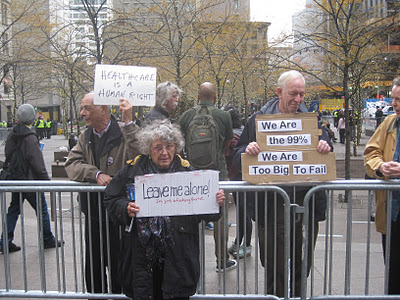
Out of the Frying Pan and Into the Fire: The Nomadic Life of an #OWS Occupier Sans Occupation
David Everitt-Carlson
Occupiers without a place to occupy. What do they do? Where do they go?
::::::::
Native America: The author's teepee in Zuccotti Park
My exit from the New York City 30th St. Men's shelter (Bellevue) on November 3rd was uneventful. Resolved maybe. It wasn't so hard to choose not to have one's psyche attacked by the government and the myriad of insane laws against the homeless in search of more US budget cutting as cities spend millions to rid their centers of anti-corporate/government 'Occupations'. It made a lot more sense to become an occupier of public spaces, instead of remaining a prisoner in them. Why not build a teepee on Wall Street and really piss em' off? When one has nothing to loose they don't feel so much revolutionary but rather evolutionary - the old rules having outgrown any usefulness and a set of new ones just waiting to be written. When the government criminalizes the state of not being able to make enough money to survive in even a modicum of decency (click prior for Huffington Post story), one doesn't feel so much like an outlaw as they might feel like a pioneer - breaking ground that will not be common for quite some time, but common to be - just getting there first.
The Beginning of the Beginning
The police raid of the Occupy Wall St. camp in the early hours of November 15th came at just the right time, a time when the movement was running out of steam and festering in its own philosophical excrement. "Time to put that rubber to the road boys", said the government. "Let's see if this is just an adolescent camp-out or a real social upheaval. Nothing like pouring a few vats of boiling oil over the walls of the castle to see what those peasants are made of", they said.
And so we left - most of us. A few stayed to make an impassioned stand at the center of the camp but that was pre-scriptedly pointless and those of us who left voluntarily already knew that. I walked with a guy named Steve up to Foley Square to find the first refugees but that was pointless as well. The majority of those would simply go home to a nice warm bed once they figured out there was nothing more to prove by occupying a place nobody gave a sh*t about anymore. Steve and I were headed for an all-night cafe with wifi so we could follow the news feeds and begin to fight the fight digitally. Neither of us slept at all that night.
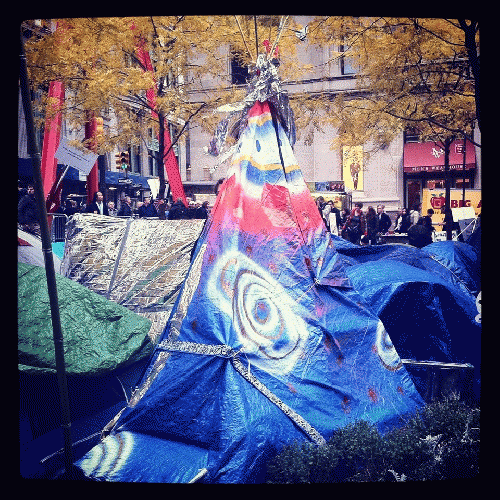
The next night at Judson church at Washington Square opened for maybe 50 occupiers. That worked for a few nights and was haphazardly served with food and blankets for sleeping by OWS. Here it became apparent the the organizers had no plan post Zuccotti Park, but also had no idea just how many real homeless and psychologically challenged occupiers they really had. They had a lot. The church was plagued by incidents of thefts, drug use and gay sex in a room for 50. Personally, I didn't see any of that, but that doesn't mean it didn't happen. The church simply closed its doors after a few nights with no real word of what had happened.
Riverside Church: Shelter from the Lord
I spent the next night at the Riverside Church at 122nd street just below Harlem after being turned away from a church on 86th St. because they were full. Built by John D. Rockefeller and a former host to Dr. Martin Luther King, the Riverside sports a 24 storey bell tower (fully functional with classrooms and offices) that imposes itself on the Hudson. Sleeping in a basketball gym attached to the church, we dined on the remains of someone's banquet served for dinner - with tons of cheese, something occupiers rarely see. But the nefarious activities continued as phones disappeared and drug use was reported. We lasted a few nights there until we arrived one night to find the doors locked and no explanation as to why. I walked with two others in the pouring rain to 86th street again, only to be turned away by a very stressed staff. 50 more occupiers had just hit the streets with nowhere to go. We all jumped the turnstyles at the subway to find other places to stay. I ended up at Grand Central station and hid myself behind a Christmas display to sleep. Luckily no one saw. Luckily no one knew me or that I was occupying a capitalist manger. No room at the inn had led to this. Where are the three wise men when you need them?
The next night saw me pulling up some tables for shelter in front of a restaurant on 2nd Avenue at 2am and sleeping under them without a cover. The Ukranian owner woke me up the next morning screaming he would call the police if I didn't get the hell out - so I got the hell out.
The Middle of the Beginning
That evening I had my first meeting with Dr. Kim Hopper. Dr. Hopper, adjunct professor, Columbia School of Law is a medical anthropologist who also works as a research scientist at the Nathan S. Kline Institute for Psychiatric Research where he co-directs the Center for the Study of Issues in Public Mental Health. He is author of Reckoning with Homelessness (Cornell University Press, 2003), a stocktaking of two decades of research, advocacy, and theoretical work in that field, He also served as president of the National Coalition for the Homeless from 1991-1993. Shirley Lindenbaum of the CUNY Graduate Center summarizes Dr. Hopper's book as such: "In its poetic sensibility, passion, and political purpose, Kim Hopper's tale of homelessness in the United States rivals George Orwell's classic account of unemployment in pr-war Britain.
A man and his box: The author in Zuccotti Park
Kim and I were introduced by Cynthia, a psychiatrist who had found me in Zuccotti park, painting a box. A box which said, "I think Outside My Box". If interested in me as an artist, a cliche writer with a visual twist or as a clinical study, Cindy visited me on a few different days and then suggested that Kim and I meet. It had taken nearly two months to make that happen. Once introduced we talk of collaborating on a project for one of his university studies.One of the things I am told often by other homeless and people familiar with the academic study of the subject is that, "You don't know anything about the homeless unless you've been there".
I remember asking Douglas Lopez, my first case worker, if he had ever been inside the Bellevue men's shelter on 30th St. as he was checking me in to the place. "No, I haven't", he said. And it took me a while to learn that if any of the caseworkers working outside the shelter system had ever been inside the shelter system, they would never send anyone there. Aside from the threats of theft, bodily harm and sometimes even death, reported regularly by the New York press, the psychological debilitation on a daily basis was just too much for me, too wrong for me - and I am no anomaly in these cases. The instances of 'voluntary homelessness' grow every day - from those who find they would much rather deal with the vagaries of the street than the oppression of a careless plutocracy or an autocratic family. And whether Occupy Wall Street ever wanted to be a conduit for the homeless in search of a society of compassion and care or not - it is now - and there is no turning back. The Occupy movement, for whatever politics it may represent, has always presented itself as an inclusive society as opposed to the exclusive one as represented by the 1%. And so now the movement immediately is faced with dealing with one of America's most humiliating and inhumane social contradictions - the idea that we find it preferable to spend billions to kill people in other countries who don't share our ideology - an ideology that is incapable of or disinterested in care for the needy of its own country. Sick fucks we are when you think about it.
Dr. Hopper seeks to deal with the homeless problem from an academic perspective. And the Coalition For the Homeless deals more with it on a corporate level, but never, before the Occupy movement, have the people affected by the problem been tasked with finding a solution. Maybe it is now time for the inmates to run the asylum. After all, they know the problem best because they are in part, part of it. As a societal movement then, it only makes sense for Occupy to step up and be part of the solution.
I left that evening and needed to bum money from Cindy for my train up to 86th street again. I had spent a greater part of the day sending emails to all the right people to get on the list and receive confirmation of my stay on the premises, but once arrived was greeted by a man with an iPad who finger swiped and insisted I was not to be admitted. "I see your reservation and I see your confirmation but it's my decision and I say you're not getting in", he said. Days previous had been filled with guest conflict and he was simply in no mood for new blood that might possibly be bad blood. So out to the street I went. Again.
No part of the plan: How New School Went Old School
The New School Occupation had sprung up in the past week as an affinity project in line, but not supported financially or administratively by Occupy Wall Street. Nevertheless, information had gotten out that they were indeed open to occupants so long as you had a valid ID. With no room at the 86th St. inn it seemed only logical to see if I could get in at the New School. As occupations go, the basic idea is to commandeer an otherwise public space and use it for voicing public grievances. And in this, the organizers of the New School Occupation had succeeded admirably - so much so that the administration of the school had sanctioned the action and the students had a picture of the school president, standing in solidarity with the members, to prove it.
But having taken over a student study space complete with two escalators, modern furniture/lighting, carpet, heat, hot and cold running water, Macintosh computers and enough paint to graffiti Australia, they began treading a fine line between occupation and degradation of a space meant for all. For all the media hoopla given to the makeshift tent city that had been assembled in Zuccotti Park for OWS, it hurt no one, and didn't damage public property at all, save for a few trampled plants. But the New School occupation had taken things a step further. As I arrived not a space was available for new graffiti on any wall. It was already covered and covered thrice over - so much so that it restricted my painting activities to the ceiling for the duration of my stay. As the place had already been trashed, there could be very little I could do to make it worse, so my work on the ceiling made it arguably better - a Sistine Chapel for revolutionaries so to speak.
My arrival was greeted warmly, if not enthusiastically. "You're the dude in the box", someone said. "Have some food", said another. In this space people could smoke, drink beer and even smoke pot. It was art school all over again for me. Heaven in some sense. A warm place to paint and contemplate - a place for me to put the real world on hold and work towards a better one. But the organizers had different ideas - some not very good ones. GAs (General Assemblies) were fraught with conflicts and ended in disarray. A general paranoia about being booted by the cops circulated daily and with good reason. As conditional with the university's support of the occupation, the school wanted them to move - to a space a block away and out of the traffic of 14th St. - an art gallery and part of the Parson's School of design. Understandably the occupiers objected to the move. The new space had only one room, no computers and was set up like a fishbowl to the sidewalk on 13th St. - onlookers being able to peer in at the animals on display. " k'y
k'y -p
-p
 as", the sign would read. "Homo-erectus-occupotomus", it would say below in Latin..The new space would also allow guards to monitor and electronically lock the only way in and out. Essentially, they could lock you in or out of the space at will - and many people's wills were at test here - the students in being true radicals, and the administration in being true guardians of student safety, parent financing and the public trust as a whole.Way too many egos on the line here.
as", the sign would read. "Homo-erectus-occupotomus", it would say below in Latin..The new space would also allow guards to monitor and electronically lock the only way in and out. Essentially, they could lock you in or out of the space at will - and many people's wills were at test here - the students in being true radicals, and the administration in being true guardians of student safety, parent financing and the public trust as a whole.Way too many egos on the line here.
So the students decided to act out as they had in too many childhood tantrums before. Too many years in upper middle class homes with little to worry about except which video game platform to support, Facebook and Twitter cred were at stake here. How bad could they be without actually killing anybody? And where they could have chosen to have been modern day Che Guevara's or Ho Chi Minh's, instead they just bought the t-shirts and resorted to the predictable sophomoric antics of painting defamatory slogans on the walls (photo) and generally trashing the place. I left in the middle of thei Thanksgiving day declaration of stupidity and headed for the new space. Having now broken laws, equipment and trust, the original leaders of this 'leaderless' group scurried like rats into the night leaving $45,000 in physical damage in their wake. The rest of us were evicted from the new space the next morning - not surprisingly.
The End of the Beginning
John Baxter speaks with a thick Irish brogue but has been an American citizen for the past 45 years. The New York Times profiled he and his hotel at Rockaway Park a few years ago. "Please read all the house rules carefully or ask management to read them to you" , states the sign in the lobby of the Baxter Hotel - Just a look at the outside let's you know what you might be in for on the inside. Baxter has been a supporter of Occupy Wall Street since the very beginning and when he heard of the eviction of Zuccotti Park's most famous residents, he offered his hotel as refuge for the displaced occupiers. At no cost to OWS at all.
Home Sweet Home Rockaway
"If you need a home in a hurry and do not mind salt air and salty neighbors, with $130 and your own roll of toilet paper you can move into the Baxter Hotel in Rockaway Park, a half-block from the Atlantic Ocean.", reads the Times. "$130, with no deposit, no security and no questions asked.". but after a week, the occupiers seemed to have broken at least one unwritten rule. Asked about the house rules, Baxter's manager, Mr. Reeder said, "Just don't do anything to make us kick you out." At the end of the A train line and indeed at the end of the road of life for many, lies the shoreline at Rockaway beach. Comparable to the Hamptons in terms of surf and sand quality, Rockaway Beach remains famous only in an old Ramones song and infamous in that the strip of sand is lined with project housing and S.R.O, old folks and psychiatric homes for those even too unsavory to live in the city proper - and if you believe many of the press reports on the now evicted OWS camp at Zuccotti, perfect for the occupants. But they fucked even that up somehow.
I awoke one morning to the arguments of an iPhone robbery, a drunk guy and an unapologetic call to Baxter from OWS housing. The last straw had fallen at the last stand. We were told we had one night left and that would be the end of it. I spent the day trying to arrange alternative housing and returned around midnight to find the security rollscreens down and padlocked tight. In my day away, even our one more night had fallen away. I spent the night sleeping on the train and ending up at Grand Central for a finish nap on one of the old benches downstairs, sleeping upright so as not to be jostled or arrested by the police in the AM. Finding nowhere suitable the next day, I considered Grand Central again but found it being cleaned out of vagrants at 2AM by police and service workers. That night I curled up in a recessed door to an Indian restaurant named Nirvana on Lexington. The irony of the name was not lost on me. I awoke the next morning at six to the sounds of trucks and traffic getting to start another day. And so would I, thankfully.
Leave me alone! I'm just a f*cking tourist!
The church at 86th St. is called St Paul and St. Andrews (I didn't even know they were friends) and has been a friend to protesters, the homeless and other divergent groups in the city for years. In the days during our Rockaway stay, SPSA had had a change in OWS management and was suggested to me again as an option again. A few more emails and a stop by the door and I was in - and allowed by the same guy who had turned me away so many times before. Occupations are evolving beings, and finally, this one had evolved in my direction.
I have been there four nights now and it's a very comfortable stay. We sleep in the warm and carpeted sanctuary and even have a grand piano at our disposal - although we could do without some of the professed pianists. During my days at the occupation I've evolved the box painting into making signs for ersatz protesters. The signs I make are funny and geared to putting a lighthearted spin on the whole affair. The one above, "LEAVE ME ALONE, - I'm just a f*cking tourist" was made as a joke that I didn't think anyone would actually buy. But the woman came up, took a look, and told her son, "I want that one, because I'm a tourist". She had arrived that day from Florida and told her son the first thing she wanted to see was Occupy Wall Street. Funny how these things work out.
Recently there was a story where Chelsea Clinton quoted her grandmother regarding how she lived her life in the spotlight. "Life is not about what happens to you, but what you do with what happens to you", her grandmother said. And that is exactly how I have come to treat this experience. If you like the stories, please pass them on.
Submitters Website: http://ahomelessbloggerinnyc.blogspot.com
Submitters Bio:
David is a marketing consultant and writer living in New York. He formed Korea's first 100% foreign invested advertising agency in 1997 and spent 16 years in Asia and Europe as an international entrepreneur and writer and has written for Technorati and The Morton Report. In 2011 David became heavily involved in Occupy Wall Street and holds the distinction of being the only person ever to build and live in a Teepee in occupied Zuccotti Park.
http://www.opednews.com/populum/printer_friendly.php?content=a&id=142884

